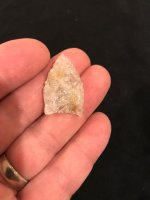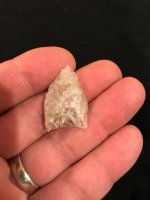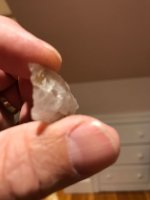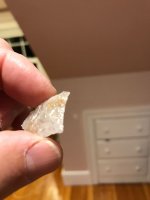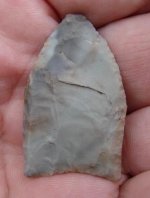Navigation
Install the app
How to install the app on iOS
Follow along with the video below to see how to install our site as a web app on your home screen.
Note: This feature may not be available in some browsers.
More options
You are using an out of date browser. It may not display this or other websites correctly.
You should upgrade or use an alternative browser.
You should upgrade or use an alternative browser.
I’m calling it a Clovis. I found this crystal quartz point in April 2013 in Plymouth
- Thread starter MAMucker
- Start date
arrow86
Silver Member
It’s unfortunate that quartz points show so poorly in pics so I’m sure you will get a lot of doubters of it being Clovis ... maybe try pics in different lighting or adjusting the contrast / settings to show the base and flute better
SportsmanAll
Full Member
- Mar 21, 2018
- 179
- 302
- Primary Interest:
- All Treasure Hunting
I can see what your talking about.
It's hard to see in the photos, by no fault of your own... Just the material makes it hard to see. It might be hard to date it conclusively without other finds. Is the base really ground or is it a faint stem? It could be a Fox Creek point. For your sake, it would be a nice clovis.
Quartzite Keith
Full Member
- Dec 17, 2018
- 179
- 406
- Primary Interest:
- All Treasure Hunting
I like it. Certainly would not be out of place for a Clovis site down here in Virginia. The fluted on one side and kind of BSed on the other side is common for the "second string" type materials.
MAMucker
Bronze Member
- Thread starter
- #7
I like it. Certainly would not be out of place for a Clovis site down here in Virginia. The fluted on one side and kind of BSed on the other side is common for the "second string" type materials.
I like it too! Second String Material —-we are loaded with it here.
So I’m going to add a bunch of new photos here and hopefully you all can see what I can see and can feel.
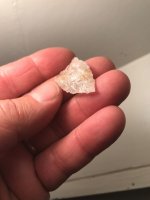
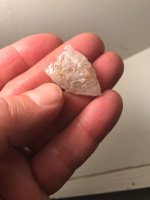
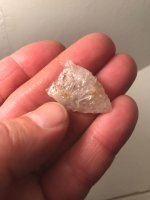
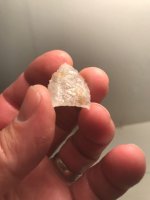
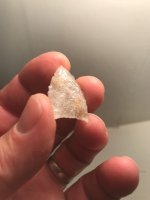
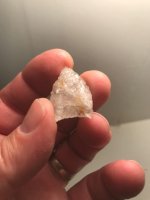
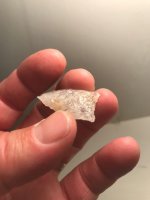
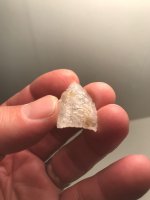
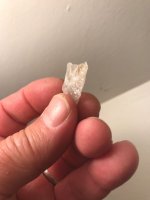
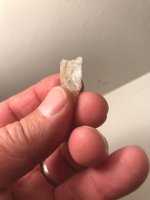
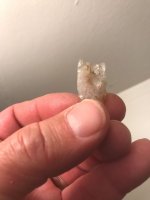
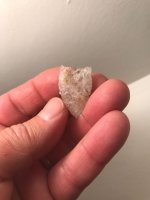
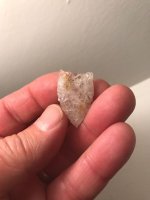
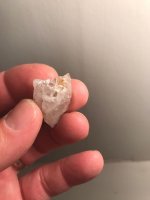
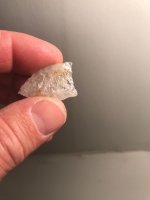
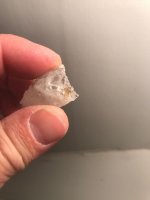
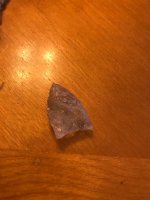
Yes, it's a clovis. I have one similar to yours I found in Maryland 40 years ago. These little ones were generally resharpened down from bigger ones.
arrow86
Silver Member
Those pics are are better I think Smokeycat is right it looks like it has been resharpened/ reused quite a few times , it seems that not many quartz Clovis are found that’s a sweet point . Was this a shoreline or field find?
CaptEsteban
Bronze Member
- Jul 26, 2011
- 1,272
- 1,201
NICE point, especially since it is quartz !!
Charl
Silver Member
In southern New England, true miniature fluted points have been found, of both the Bull Brook variety, and the Barnes( aka Neponset) variety. At the Templeton site in western Ct., an intact Barnes fluted point only 3/4" long was recovered.
Most New England fluted points were made of exotic lithics from distant sources, often Hudson Valley cherts, or cherts from northern New England, but there were exceptions. The Sugarloaf site near Deerfield, Ma. produced nice rhyolite Bull Brook fluted points, along with those made from NY Normanskill chert. The base of a quartz crystal fluted point was recovered from the Sands of the Blackstone site, near the RI border. Years ago, my wife and I found a miniature fluted point, made of quartzite, and probably of the Bull Brook variety, on Narragansett Bay.
Miniature fluted points may be more common then folks realize, at least here in New England. And fluted technology seemed to persist longer here, perhaps because caribou migration persisted later here....
Most New England fluted points were made of exotic lithics from distant sources, often Hudson Valley cherts, or cherts from northern New England, but there were exceptions. The Sugarloaf site near Deerfield, Ma. produced nice rhyolite Bull Brook fluted points, along with those made from NY Normanskill chert. The base of a quartz crystal fluted point was recovered from the Sands of the Blackstone site, near the RI border. Years ago, my wife and I found a miniature fluted point, made of quartzite, and probably of the Bull Brook variety, on Narragansett Bay.
Miniature fluted points may be more common then folks realize, at least here in New England. And fluted technology seemed to persist longer here, perhaps because caribou migration persisted later here....
southfork
Bronze Member
Beautiful old fluted point great find .
joshuaream
Silver Member
That is a beautiful relic, and very nice quality pictures of a notoriously difficult material to photograph.
If it were mine, I'd like lean towards some post-Clovis. The resharpening doesn't look Clovis like to me (specifically the needle point tip and the slightly off center point from resharpening), those are more common traits on other later paleo points that are Dalton age.
As Charl mentioned, New England was a bit of a unique area where you likely had fluted point users hanging on later hunting Caribou while other parts of the US were using solidly late paleo/early archaic methods. I guess there were some cross over of technologies at times.
If it were mine, I'd like lean towards some post-Clovis. The resharpening doesn't look Clovis like to me (specifically the needle point tip and the slightly off center point from resharpening), those are more common traits on other later paleo points that are Dalton age.
As Charl mentioned, New England was a bit of a unique area where you likely had fluted point users hanging on later hunting Caribou while other parts of the US were using solidly late paleo/early archaic methods. I guess there were some cross over of technologies at times.
arrow86
Silver Member
Yes, it's a clovis. I have one similar to yours I found in Maryland 40 years ago. These little ones were generally resharpened down from bigger ones.
What part of MD ? Would love to see it
MAMucker
Bronze Member
- Thread starter
- #20
That is a beautiful relic, and very nice quality pictures of a notoriously difficult material to photograph.
If it were mine, I'd like lean towards some post-Clovis. The resharpening doesn't look Clovis like to me (specifically the needle point tip and the slightly off center point from resharpening), those are more common traits on other later paleo points that are Dalton age.
As Charl mentioned, New England was a bit of a unique area where you likely had fluted point users hanging on later hunting Caribou while other parts of the US were using solidly late paleo/early archaic methods. I guess there were some cross over of technologies at times.
Josh and Charl,
Thank you for your insight and knowledge. I appreciate the years of study and hard work you have invested in this area of Archeology. I’ve been reading your posts and responses for many years, while silently learning from people like you on this forum.
It is very much appreciated!
Top Member Reactions
-
 3480
3480 -
 1986
1986 -
 1912
1912 -
 1160
1160 -
 1090
1090 -
 1010
1010 -
 889
889 -
 864
864 -
 860
860 -
 795
795 -
 759
759 -
 676
676 -
 659
659 -
 567
567 -
 508
508 -
 453
453 -
 447
447 -
 410
410 -
 401
401 -
E
398
Users who are viewing this thread
Total: 2 (members: 0, guests: 2)
